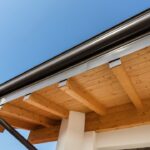What is a Cool Roof? This question has become increasingly relevant to homeowners seeking energy efficiency solutions. A cool roof reflects more sunlight and absorbs less heat, thanks to its specialized design and materials. This innovative technology brings tremendous benefits, helping to reduce energy bills and increase the comfort of your home.

Understanding the Basics of Cool Roofs
A cool roof utilizes materials that reflect the sun’s rays. These roofs can be made from a variety of materials, including reflective coatings, tiles, or special membranes, all designed to keep temperatures lower.
How Does a Cool Roof Work?
The science behind cool roofs is straightforward. They work by reflecting more sunlight and emitting more heat than standard roofing materials. This means your home stays cooler during the hot summer months, reducing the need for air conditioning.
Types of Cool Roof Materials
- Reflective Coatings: These coatings are applied like paint and can be added to existing roofs to enhance reflectivity.
- Cool Roofing Membranes: These are pre-fabricated sheets that cover the roof, often used in commercial buildings.
- Reflective Shingles: Designed to reflect more sunlight than traditional shingles, making them a popular choice for residential buildings.
Benefits of Cool Roofs
Investing in a cool roof offers a range of benefits that make them an approved choice for those looking to enhance their home’s energy efficiency.
Energy Savings
One of the most significant advantages is the energy savings. By reducing the need for air conditioning, homeowners can see a substantial decrease in energy bills.
Improved Comfort
Cooler roofs lead to more comfortable home environments, especially during peak summer months when temperatures can soar.
Reduced Carbon Footprint
By lowering your home’s energy consumption, cool roofs contribute to a reduced carbon footprint, supporting environmental sustainability.
Installation of Cool Roofs
Installation is a critical aspect to consider. Homeowners should work with qualified professionals to ensure that the materials and techniques used are reliable and long-lasting. Here’s an internal link that can help you choose contractors.
DIY vs. Professional Installation
While some may consider DIY options, professional installation often ensures better longevity and performance, given the technical nature of these roofs.
Maintenance Tips
Maintaining a cool roof involves regular inspections and cleaning to ensure maximum reflectivity. Checking for wear and tear can also prolong the life of your roof.
Cost Considerations
The cost of installing a cool roof can vary based on materials and labor. However, the long-term energy savings often justify the initial expense. Check out this [link](https://www.bobvila.com/articles/roof-replacement-cost/) for more information on roof replacement costs.
Comparing with Traditional Roofing Costs
Cool roofs may have a higher upfront cost but offer greater savings over time. Comparing these costs with traditional roofing options can help you make an informed decision.
Cool Roofs and Climate
The effectiveness of a cool roof can depend on your location and climate. Warmer regions benefit most from this technology, tapping into its tremendous advantages.
Cool Roofs in Different Geographical Areas
Areas with high temperatures stand to gain the most from cool roofs, although cooler climates can still see benefits during the hotter months.
Environmental Impact
Cool roofs play a part in combating urban heat islands, where city areas become significantly warmer than rural areas. This can help in reducing overall environmental temperatures.
Conclusion
The technology behind what is a cool roof is here to improve our homes in a big way. Whether you’re looking for energy savings, reduced environmental impact, or increased home comfort, cool roofs represent a terrific approved option that can meet all these needs.

FAQs
What makes a roof ‘cool’?
A roof is considered ‘cool’ when it uses materials that reflect more sunlight and absorb less heat.
Are cool roofs only for hot climates?
While they are most effective in hot climates, they can also provide benefits in cooler climates during warm seasons.
Do cool roofs require special maintenance?
Like any other roof, cool roofs require regular inspections and maintenance, but their maintenance is not particularly specialized.
This article contains affiliate links. We may earn a commission at no extra cost to you.








